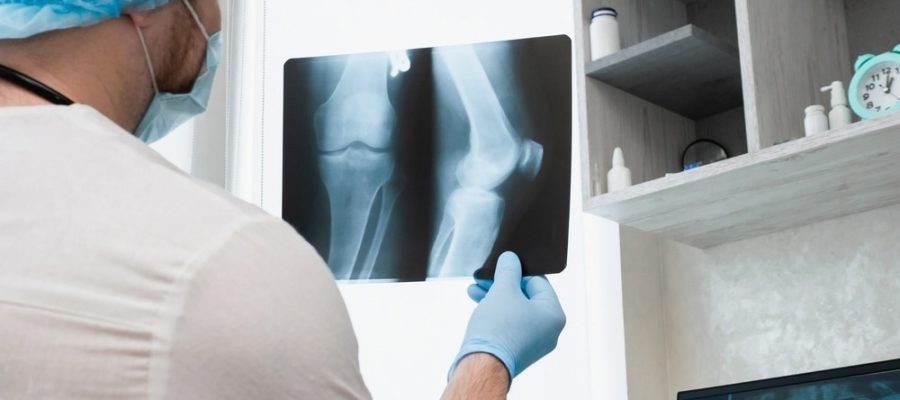Cause and symptoms
Genetics
Epidemiology
Case report
Diagnosis and treatment
References
Further reading
Melorheostosis, also known as Leri disease, is a rare non-genetic sclerotic bone disease. The name melorheostosis is made from the combination of three Greek words: melos (limb), rhein (flowing), and ostosis (bone formation). It is a chronic condition marked by dense cortical sclerotic bone and adjacent soft tissue structure in a sclerotomal distribution.

Image Credit: Video_Stock _Production/Shutterstock.com
Mutations in the MAP2K1 gene are believed to be responsible for almost half of all instances of melorheostosis. This condition is not hereditary and cannot be passed down to offspring. It is caused by somatic mutations in bone cells that develop during a person's life.
It was first described in 1922 by Leri and Joanny, and until now, more than 400 cases have been reported in the literature. Melorheostosis is more frequent in the appendicular skeleton than in the axial skeleton and usually manifests as lower limb malformation. A combination of clinical and radiological features is used to make the diagnosis
Cause and symptoms
Isolated Melorheostosis (with no other associated disorders) is more common in those who have no family history of the ailment. Approximately half of all isolated Melorheostosis cases are caused by acquired, somatic genetic alterations in the MAP2K1 gene. These genetic mutations are not inherited from one's parents and occur randomly throughout one's life. The etiology of the remaining cases is unknown.
Although some cases of melorheostosis are identified by chance before the development of signs or symptoms, pain, stiffness, and limitation of joint motion or deformity are frequently the first symptoms that drive patients to seek medical attention.
The onset is gradual, and symptoms range from none to severe deformity due to contracture. Cranial nerve paralysis, ectopic ossification in muscle tissue, increased bone mineral density, and hyperostosis are frequently observed. Skeletal muscle atrophy and asymmetry in the lower and upper limbs are also frequent.
Osseous involvement can be monostotic or polyostotic, or monomelic, but it is usually confined to one limb. However, it can also be bilateral. The most common form of this rare disease is the monomelic variety. When polyostotic, it generally crosses joint gaps while remaining sclerotomal. Limb length disparity can occur as a result of asymmetric early epiphyse fusion.
Early onset and inclusion of numerous limbs may suggest a worse outcome in terms of complications. Melorheostosis is characterized by uneven thickening of cortical bone, which appears in classic cases like "melted wax flowing down a candle."
Genetics
The MAP2K1 gene codes for a protein known as a MEK1 protein kinase. This protein is found in a variety of cells, including bone cells. It is a component of the RAS/MAPK signaling pathway. This signaling system regulates cell proliferation, differentiation, and migration. RAS/MAPK signaling is required for proper development, including bone formation.
The mutations result in the creation of an overactive version of the MEK1 protein kinase, which enhances RAS/MAPK signaling in bone tissue. Increased signaling affects the regulation of bone cell proliferation, allowing for aberrant bone growth.

Image Credit: Billion Photos/Shutterstock.com
According to research, elevated RAS/MAPK signaling also promotes excessive bone remodeling, a normal process in which old bone is broken down and new bone is formed to replace it. Alterations in bone development and turnover cause bone abnormalities associated with melorheostosis.
Epidemiology
Melorheostosis is most common in youth or early adulthood, with an incidence of 0.9 per million. Although alterations develop in early childhood, the age at presentation is frequently later, and the disease frequently remains undiagnosed until late adolescence or early adulthood. Only about half of the time is the diagnosis made before age 20.
Case report
Kumar et al. described a 35-year-old lady complaining of left leg pain, minor edema, and limited knee movement. Her limb pain had been present for the past 20 years. The edema and restriction of joint movement progressed progressively. There was no relevant family history or trauma to speak of. On inspection, there was no tender bony hearing, edema, hyperpigmentation, or restriction of knee movement. Plain radiographs revealed widespread, thick, undulating, or irregular cortical hyperostosis that resembled candle wax and ran the length of the bone. The patient was given Pamidronate as well as an analgesic. Physiotherapy for the deformity began.
Diagnosis and treatment
Melorheostosis is difficult to diagnose because it can present with clinical and radiologic symptoms comparable to tumors and other sclerosing bone disorders, such as intramedullary osteosclerosis and osteopoikilosis. Although the typical radiographic "dripping candle wax" appearance aids in diagnosis, it is not a ubiquitous finding in melorheostosis patients. As a result, the absence of a thorough pathologic description and a confirmation test can make the diagnosis subjective.
Melorheostosis morbidity appears to be mostly caused by discomfort, contractures, limits of joint motion, limb length disparities, and osseous abnormalities. In the past, tendon lengthening, excision of soft tissue masses, the release of joint contractures, and osteotomies were the primary treatment choices, but recurrence is prevalent. There are no clinical trials or recommendations to guide medical treatment for painful hyperostosis. Targeting the cause of discomfort in melorheostosis may aid in therapy. Bisphosphonates and other antiresorptive medicines are often utilized for pain management. Typically, a multimodal approach is used, with coordinated care emphasizing pain control and functional restrictions.
References
- Fick, C. N., Fratzl-Zelman, N., Roschger, P., Klaushofer, K., Jha, S., Marini, J. C., & Bhattacharyya, T. (2019). Melorheostosis: A Clinical, Pathologic, and Radiologic Case Series. The American journal of surgical pathology, 43(11), 1554–1559. https://doi.org/10.1097/PAS.0000000000001310
- Kotwal, Anupam, and Bart L Clarke. "Melorheostosis: a Rare Sclerosing Bone Dysplasia." Current osteoporosis reports vol. 15,4 (2017): 335-342. doi:10.1007/s11914-017-0375-y
- Smith, Gabriel C et al. "Melorheostosis: A Retrospective Clinical Analysis of 24 Patients at the Mayo Clinic." PM & R: the journal of injury, function, and rehabilitation vol. 9,3 (2017): 283-288. doi:10.1016/j.pmrj.2016.07.530
- Kumar, R., Sankhala, S. S., & Bijarnia, I. (2014). Melorheostosis – Case Report of Rare Disease. Journal of orthopaedic case reports, 4(2), 25–27. https://doi.org/10.13107/jocr.2250-0685.162
- Melorheostosis. [Online] MedlinePlus. Available at: https://medlineplus.gov/genetics/condition/melorheostosis/
- Melorheostosis. [Online] NIH-GARD. Available at: https://rarediseases.info.nih.gov/diseases/9474/melorheostosis
- Melorheostosis. [Online] Radiopaedia. Available at: https://radiopaedia.org/articles/melorheostosis-1
Last Updated: Apr 25, 2023
Source: Read Full Article
